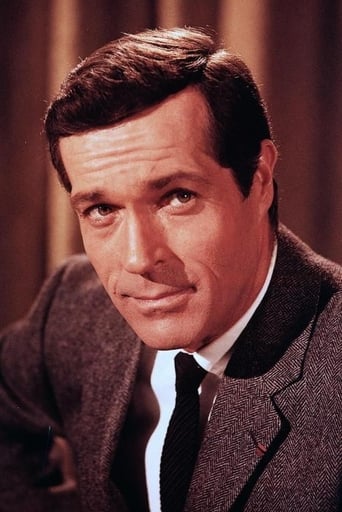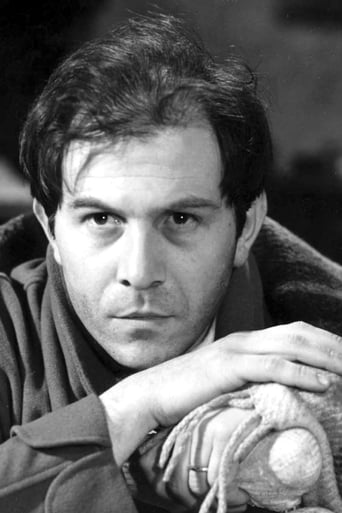Phonearl
Good start, but then it gets ruined
Siflutter
It's easily one of the freshest, sharpest and most enjoyable films of this year.
Tayloriona
Although I seem to have had higher expectations than I thought, the movie is super entertaining.
Dana
An old-fashioned movie made with new-fashioned finesse.
Robert J. Maxwell
It's a dubbed Italian production in lurid color dealing with the Axis defeat by the British and colonials in North Africa. Now, I hate to call it "operatic." But at the very opening, an Italian unit is motoring towards the front, singing a jolly song, the feathers on their caps pluming, when they're fired upon by a British machine gun. You should see them die as they bravely attack the enemy position in mass waves. They're mowed down. But as each soldato is shot, the director (Calvin Jackson Padgett, aka Giorgio Ferroni) has him throw up his arms, execute a few pirouettes, and fling himself dramatically to the sand. Maybe it's not a cinematic trope. Maybe Italian soldiers actually DO die in a distinctly regional way. Wait, I think I can see it. The British soldier clasps a hand to the wound, looks puzzles, and sinks uncomplainingly. The French die with a xenophobic curse on their lips. The Americans shout out capitalistic slogans as they stagger about, unwilling to yield to the "sure-enwinding arms of cool-enfolding death." Germans fall face-first at attention, Russians with a few last kicks from the hopak. I know I shouldn't be joking about deaths in combat. There's nothing funny about the reality, but the movie is sometimes a joke in itself and more or less invites such treatment.The movie takes us to the upper echelons and introduces us to Michael Rennie (dubbed) as Sir Bernard Law Montgomery, now taking charge of the British forces and kicking some butt. Once that's established, we visit Rommel drawing lines on a map, complaining that he has barely enough forces to contain the British, and explaining the situation to the real historical figure of General Bastico, whom Rommel in real historical life referred to as "Bombastico." It's a tense situation all right. The Brits have been forced back to the Egyptian border and Alexandria and the Suez Canal are threatened. At the same time, Rommel's supply pipeline has been practically severed by British air and submarine attacks, so he can't advance any farther -- no men, no tanks, no fuel, not even enough water. His men urinated into water-cooled machines. The film correctly states that he was losing 60 percent of his supplies, but it doesn't mention that the Italian naval code had been broken, so the Brits knew when his supply ships would leave Italy for Tripoli. At the battle, Rommel was outnumbered two to one in troops, in tanks, and in the air.It's not a bad film once you're able to get past the accidental qualities -- the dubbing, the often sluggish direction. The story sticks pretty close to actuality in depicting the overall military arrangements. I don't know about the details. All three sides -- Italian, German, and British -- are shown to have human qualities. No one is a sneering villain. Everyone makes a misjudgment from time to time. The location shooting is adequate. It's a desert all right. The special effects are of the period, and the musical score points us in the direction it invites our emotions to take. The repulse of the British patrol by the Italian Folgore (Lightning) Division of paratroopers is accurately described (except for the absence of tanks). Rommel commended the division for its bravery. The uniforms and helmets of the Italian troops are historically accurate.Yet there's an element of clumsiness throughout. A British scouting party advances. The pipers are playing their bagpipes. But the sound isn't that of bagpipes but of some sort of electronic horns and the tune sounds more Italian than Scottish. Who chose the voices that were dubbed later? Why are so many of them baritones and so often gravelly? Who decided that a lone man with a submachine gun, trying to hold off an armored car, should kneel out in the open instead of taking cover. And when a man is extremely thirsty and is given half a cupful to drink, why does he try to gulp it down and spill half of the precious water down his chin? What was Calvin Jackson Padgett thinking? Generally the Italians are portrayed as more humane than the Germans.The Germans aren't exactly cruel but an Italian soldier criticizes them for their willingness to leave a wounded man in front of them on the battlefield. "No sense risking more lives to save one," says the German officer. "How -- logical," sneers the Italian. (When John Wayne made the same decision in "Sands of Iwo Jima," the film gave him plaudits for his heroic self-discipline.) We -- the Brits, French, and colonial troops -- won the battle of El Alamein, but not because of any weaknesses in the Folgore Division. Vastly outnumbered and out gunned, they fought with everything at hand. The use of Molotov cocktails shown in the movie was not made up. Out of ammunition, some of the survivors retreated to Tunisia, where they fought again, while others surrendered at El Alamein. The battle, in fact all the battles of North Africa, were slugging matches, with both sides hemmed in by the Mediterranean on one side and the Qatarra depression, impassable to armor, on the south. It's not a bad movie. It's just that some of the elements -- the direction, the sound effect and so forth -- make it seem worse than it is.
ma-cortes
The opening prologue states : June 1942, as general Erwin Rommel swept toward the Nile , the fall of Egypt and the capture of the Suez canal seems inevitable . Italian and German advance units raced toward Alejandria . Mussolini had given explicit orders : The Italians must arrive first! . In this one , the Italians and Germans, united in a difficult Alliance , fight the British in the North Afican desert . The Italians are the good guys and the British are the bad guys , including a point blank execution of prisoners . The protagonists are two brothers , a tough lieutenant (Frederick Stafford) and a sergeant (Enrico Maria Salerno) fighting the British military . Furthermore, a brave English lieutenant (George Hilton) and , of course , Erwin Rommel (Robert Hossein) and General Montgomery (Michael Wilding). This movie gets lots of action , crossfire , gunplay and explosion . The all-star-cast formed by known European actors give decent interpretations . It displays several extras and tanks , in fact , the production wishes thanks the Italian Ministry of defense and the Italian Army general staff for their collaboration in making this film .The picture is based on the real battles , the true events were the followings : Alamein in WWII are two decisive battles in the western desert , north Egypt , in 1942 resulting in British victory over Axis forces under Field Marshal Erwin Rommel : 1- 27 July 1942 the British 8th Army under General Sir Claude Auchinleck held off the German and Italian forces . Neither side can be said to have won , but the British had the strategic advantage of short supply lines and so could reinforce faster than Germans . 23 Oct-4 Nov 1942 General Bernard Montgomery launched a diversionary British attack in the south , aiming to draw Axis forces into the area so that the main attack in the north could cut two corridors through the extensive minefields , enabling British armoured divisions to pass through and exploit the gaps . Progress was slow however and Montgomery decided to change tactics to fight what he called a 'crumbling battle' constantly switching the main emphasis to chip away at Rommel's front line and keep him guessing. Australian Division attacked along the coastal road , drawing the Axis forces toward them . Montgomery promptly launched a fresh attack further south, forcing the German armour to react in what became a major tank battle . By 3 Nov Rommel had only 30 serviceable tanks in action and on the next day began organizing his withdrawal. He was able to disengage and escape as the British were hampered by heavy rain and shortage fuel .
pmiano100
Lt. Borri (Frederick Stafford) is not so much a martinet as he is a relatively brave man who is ashamed of the Italian Army's accurate reputation for cowardice. Throughout the film, the Italians are excused for their cowardice by showing them as disillusioned and betrayed by their allies, the Germans. Rommel may be anti-Nazi, but he willingly sacrifices Italian troops to protect his own, which he really did. Borri tries to prove to his British foes and to himself that not all Italians are cowards, and winds up mistaking foolhardiness for courage.The Italians are shown as the only soldiers thinking about their families back home, like Borri's brother. This another attempt to show that they are not cowards, just peaceful, ordinary men - as if most Britons and Germans weren't. When Lt. Borri is captured by the British, no other Italian POWs will join him in his escape. They are all glad to be out of the war.In the end, Lt. Borri sacrifices his life in a heroic gesture history shows was ultimately futile. His brother and the others are taken prisoner, proud but no doubt also glad to be out of the war. Borri's brother will live to see his wife and child - if they aren't killed when the Allies invade Italy in 1943. They will spend the next 2 years slowly fighting their way against the Germans to the Alps. Italy will be ravaged in the process. That was the ultimate price Italian families paid for the cowardice of their soldiers, who mostly never expressed any regret.A well-acted, moving, if cheaply made film. However, like "Brave Gente", it is another apologia for the pathetic performance of the Italian Army. This "army" had to use poison gas to beat the Ethiopians.
Michael A. Martinez
Italy, along with much of the rest of the world, was into producing lots of cheapo war movies (mostly WW2) during the late-60's. The trend died out with the disillusionment caused by the Vietnam war, as did the popularity of these "gung-ho" war films.Battle of El Alamein isn't such a film. It's probably the most objective and anti-war film made since ALL QUIET ON THE WESTERN FRONT. While the battle sequences are big and exciting, there's nothing glamorous about fighting this kind of war. The soldiers are all shown as equally miserable, barely eeking out an existence in a network of trenches on the sunbaked deserts of North Africa. While it primarily focuses on the heroics of an Italian division (the real-life Italian army was best known as one of the most poorly-led and low-morale armies at the time), the film doesn't get too preachy and while it villifies no one, only showing how some generals (especially the fictional Schwartz) inevitably swung the battle in their enemy's favor due to their impatience and misguided ideals.THE BATTLE OF EL ALAMEIN also does a great job of blending fictional characters with nonfictional ones (like Rommel, Montgomery, Von Thoma, and Stumme) in a nonfictional setting. While the battle itself is abridged and perhaps over-simplified to focus on the Italian division, that's perhaps best for the sake of narrative, character development, and making the emotional impact as strong as possible.Stylistically, the film is done fairly well in late-60's style, with plenty of zoom-lens technique, close-ups, etc. It does drag in spots but only due to the predictability because we KNOW that the axis is gonna lose, but it does a good job keeping the suspense high by showing the Italians taking heavy losses in every engagement. We never know which characters are gonna make it through and which ones aren't.Despite it's flaws, I doubt a better, larger, or more compelling depiction of the battle of El Alamein shall ever be made.




